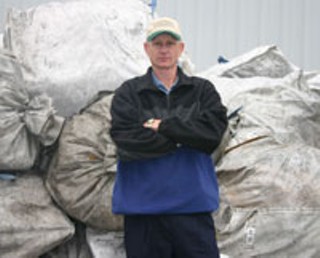In the late 80s, due to a number of environmental and waste incidents, panic struck North America: we had no more room for our garbage.
Closer to home, the problem reared its head in the form of the Sackville Landfill. The landfill, closed in 1996, produces 90 to 100 tonnes of methane gas per year and remains a concern for Halifax. A $3-million plan has been devised by Quebec-based Highland Energy to extract gas from the landfill and convert it into energy for Nova Scotia Power.
The renewable energy project hopes to deliver about two to three megawatts of power, enough to provide service to 1,500 to 2,000 homes, by early 2006. That's fine for Highland Energy and NSP, but what can the average resident of the HRM do to stem the tide of waste?
Stop believing in myths.
Marcel Maessen, HRM's Solid Waste Resources education officer, wants to excise waste-related fallacies from the minds of residents. "People sometimes think that using a green bin will attract rodents, absolutely not true that is a huge myth.”
Laurie Lewis, diversion planning coordinator for HRM, would like to see improvements in the way residents prepare what they're putting curbside and how they're putting it there. "What's problematic is the co-mingling of paper with your bottles and cans."
A blue bag can be used for both papers and plastics, they just need to be separated. Separating the contents of the bags facilitates sorting at the processing plant and keeps the paper dry; many paper recycling plants won’t accept soiled newsprint.
What can residents do to make processing easier? According to Lewis, "Our message to residents: remove caps and rinse containers, we do not require that labels be removed, a quick rinse and removing of any solids."
Those cat food tins? They don't need to be dishwasher clean, but please don't leave too many remnants of your pet's food. Processing plants and mills have been more accepting of dirty recyclables in recent years because of a demand for recycled products, but there is still a chance that loads will be rejected.
What else will lead to rejection? Plastic container tops. Lack of a sustainable market is the chief reason why plastic tops can't be recycled. Containers of plastics of type 1 and 2, mostly pop, liquid soap and other plastic drink bottles, as well as all plastic bags, can be recycled without a problem because they are in high demand. The HRM does business with a number of Nova Scotia-based recycling plants such as Novaponics, Dartmouth-based Scotia Recycling, New Minas Pulp and Paper as well as processing plants in Truro, Springhill and elsewhere. Plastic tops aren't currently a part of that business because they're made from plastics of types 3 through 7. They possess different physical characteristics than plastics 1 and 2 and can't be smelted together. They can't be recycled into drink bottles or even new tops because of hygienic concerns. The last thing the HRM wants to do is to start accepting new materials only to have the market dry up.
What about the cardboard that got left out in the rain? Moisture content does often cause a problem, but don't expect that cardboard to end up at the Otter Lake landfill. The cardboard will either dry out or be mixed with a lighter load before being shipped off to a mill.
And finally the plate you broke on the weekend? It can't be recycled. Windowpanes, plates and glasses have a different makeup than glass bottles, one that usually has higher lead content. Mills will reject the load entirely, that means that one broken drinking glass in your blue bag can spoil the whole lot. HRM currently operates within the industry average of 8 to 10 percent rejected recyclable material. Rejected waste ends up at the Otter Lake Waste Management Facility. Despite its potential for renewable energy, we don't need another Sackville Landfill.











